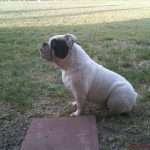Can bulldogs eat out of a slow feeder?
Feeding our furry companions is no small task. And if you’re the proud owner of a bulldog, you know just how messy mealtime can get with those adorable, droopy faces. But fear not. Enter the slow feeder – a genius invention that promises to revolutionize your bulldog’s dining experience.
In this blog post, we’ll dive into the world of slow feeders and explore whether these nifty contraptions are suitable for our lovable bulldog buddies. We’ll uncover the perks of using a slow feeder, like aiding digestion, reducing choking risks, and providing mental stimulation. But hold your kibble – we also need to consider any potential pitfalls.
So whether you’re an experienced bulldog wrangler looking for mealtime solutions or just a curious canine enthusiast hungry for knowledge, this blog post will shed light on bulldogs and slow feeders. Can these slow-feed wonders truly transform your bulldog’s dinnertime routine? Let’s dig in and find out.
Benefits of Slow Feeders for Bulldogs
Contents
- 1 Benefits of Slow Feeders for Bulldogs
- 2 Choosing the Right Slow Feeder for Your Bulldog
- 3 Introducing Your Bulldog to a Slow Feeder
- 4 Monitoring Your Bulldog’s Eating Habits with a Slow Feeder
- 5 What Are the Health Benefits of Using a Slow Feeder for Bulldogs?
- 6 How to Prevent Aggression or Frustration When Using a Slow Feeder for Bulldogs
- 7 Tips and Tricks for Getting Your Bulldog Used to Eating Out of a Slow Feeder
- 8 Common Mistakes Made When Using a Slow Feeder with Bulldogs
- 9 Conclusion
French Bulldogs are known for their adorable faces and playful personalities. However, they also have a reputation for being fast eaters, which can lead to various health problems. That’s where slow feeders come in. These specially designed feeding bowls can help our furry friends slow down their eating pace, improve digestion, prevent weight gain, and provide mental stimulation. Let’s dive into the benefits of using slow feeders for our beloved French Bulldogs.
Improved Digestion:
Bulldogs have a tendency to gulp down their food without properly chewing it, which can result in bloating and indigestion. Slow feeders encourage Bulldogs to take smaller bites and chew their food thoroughly, aiding in better digestion and reducing the risk of gastrointestinal issues.
Mental Stimulation:
Eating from a slow feeder is like solving a puzzle for our clever Frenchies. The intricate patterns or obstacles in the feeder require them to figure out how to access their food, keeping them engaged and entertained during mealtime.
Portion Control:
Bulldogs are prone to overeating, leading to weight gain and associated health problems. With a slow feeder, you can control the amount of food dispensed at each meal more effectively, helping maintain a healthy weight for your Frenchie.
Prevention of Gulping and Choking:
The design of slow feeders encourages Bulldogs to take smaller bites and chew their food thoroughly before swallowing. This reduces the risk of food getting stuck in their throat or causing discomfort while eating, preventing gulping and choking incidents.
Brachycephalic Syndrome Relief:
Many Bulldogs suffer from brachycephalic syndrome due to their short noses. Eating too quickly can exacerbate breathing difficulties associated with this condition. By slowing down their eating speed with a slow feeder, Bulldogs can alleviate some of the breathing problems during mealtime.
Vomit Prevention:
Some Bulldogs regurgitate their food if they eat too quickly, leading to waste and potential nutritional deficiencies. Using a slow feeder can help prevent this issue by allowing your Frenchie to consume their food more gradually, reducing the chances of vomiting after meals.
Weight Management:
By slowing down their eating process, slow feeders give our Bulldogs’ satiety signals more time to kick in. This helps prevent overeating and aids in weight management, ensuring our Frenchies maintain a healthy weight and avoid obesity-related problems.
Choosing the Right Slow Feeder for Your Bulldog
French Bulldogs are notorious for their speedy eating habits. They often gobble down their food in seconds, which can lead to various health issues such as bloating, choking, and weight gain. That’s where slow feeders come to the rescue.
Slow feeders are designed to slow down your bulldog’s eating pace, promoting healthier digestion and preventing potential problems. But with so many options available, how do you choose the right slow feeder for your furry friend? Let’s break it down.
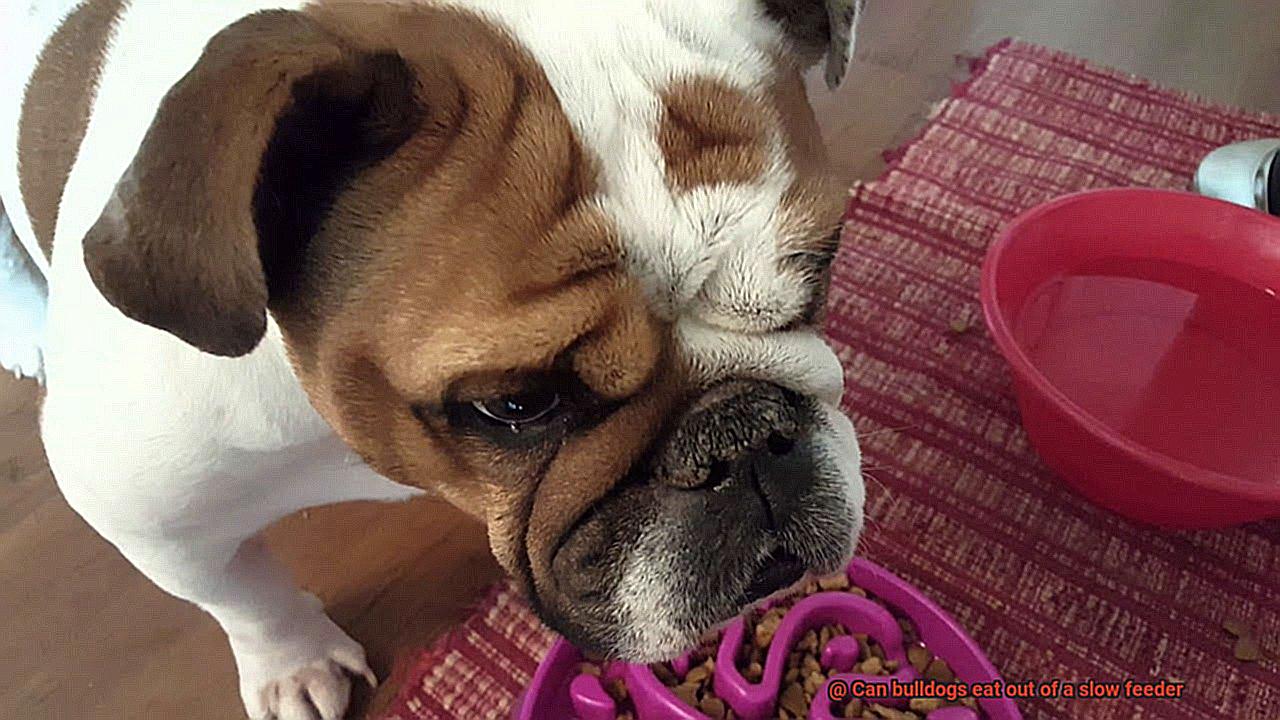
Size and Shape Matters
When it comes to choosing a slow feeder for your bulldog, size and shape are crucial factors to consider. Bulldogs have a unique body structure with a short snout and a flat face, making it essential to select a slow feeder that accommodates their specific needs. Look for feeders with wider openings or shallow pockets, allowing your bulldog to access their food easily.
Avoid feeders with small compartments or narrow openings that may frustrate your pup.
Materials Matter Too
Bulldogs are known for their strong chewing habits, so it’s vital to choose a slow feeder made of durable and non-toxic materials. Plastic, stainless steel, and ceramic are popular options, each with its pros and cons.
Plastic feeders are lightweight and affordable but may not withstand heavy chewing. Stainless steel feeders are sturdy and easy to clean but may slide around during mealtime. Ceramic feeders are aesthetically pleasing and heavy enough to stay put but can be fragile.
Stability is Key
Bulldogs are enthusiastic eaters and may push or knock over their feeder in their eagerness to get to their food. To avoid any accidents, look for a slow feeder with a non-slip base or one that can be secured to the floor. This will ensure that your pup’s feeding experience is safe and stress-free.
Easy Peasy Cleaning
Maintaining a clean and hygienic feeding area is crucial for bulldogs, as they can be prone to allergies and skin irritations. Opt for a slow feeder that is dishwasher safe or easy to clean by hand. This will make your life easier and keep your bulldog healthy.
Consider Your Bulldog’s Eating Habits and Preferences
Every bulldog is unique, so it’s essential to consider their individual eating habits and preferences when choosing a slow feeder. Some feeders have puzzle-like designs that require your bulldog to work for their food, providing mental stimulation and enrichment. Others may have different features or sizes that suit your pup better. Take the time to observe your bulldog and choose a slow feeder that aligns with their needs.
Introducing Your Bulldog to a Slow Feeder
You’ve got yourself a bulldog who loves to inhale their food faster than you can say “fetch.” Don’t worry, we’ve got just the solution for you – a slow feeder. But how do you go about introducing this nifty contraption to your furry friend? Well, let’s break it down step by step and make this whole process as smooth as a well-groomed coat.
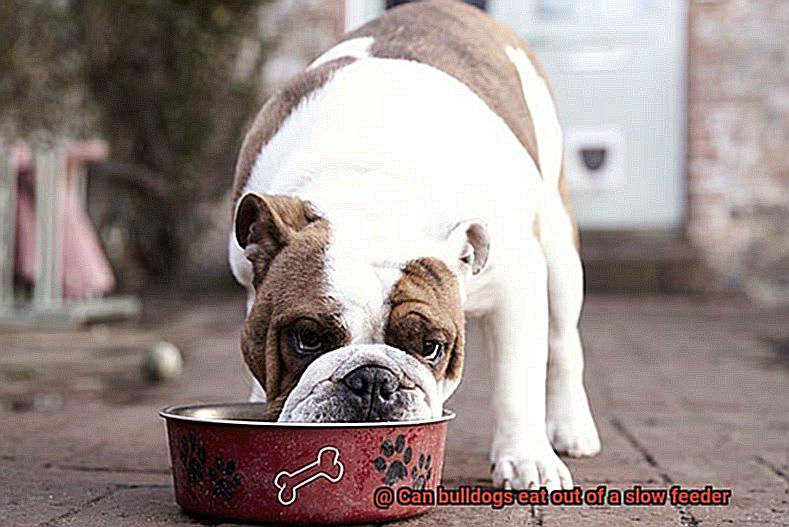
Step 1: Familiarization Station
Start by placing the slow feeder next to your bulldog’s regular food bowl. This allows them to sniff it out, check it out, and get used to its presence. You want them to feel comfortable with this new addition before diving into the main event.
Step 2: Gradual Transition
Now it’s time to make the switcharoo. Start by placing their food inside the slow feeder and removing their regular bowl. This gradual transition helps them associate the slow feeder with their meals. Remember, patience is key here – Rome wasn’t built in a day, and neither will your bulldog’s love for the slow feeder.
Step 3: Pawsitive Reinforcement
As your bulldog starts exploring the slow feeder, give them some well-deserved praise and treats. Positive reinforcement goes a long way in encouraging them to embrace this new way of dining. Who can resist a tasty treat and a pat on the head? Certainly not our four-legged friends.
Step 4: Foodie Fun Time
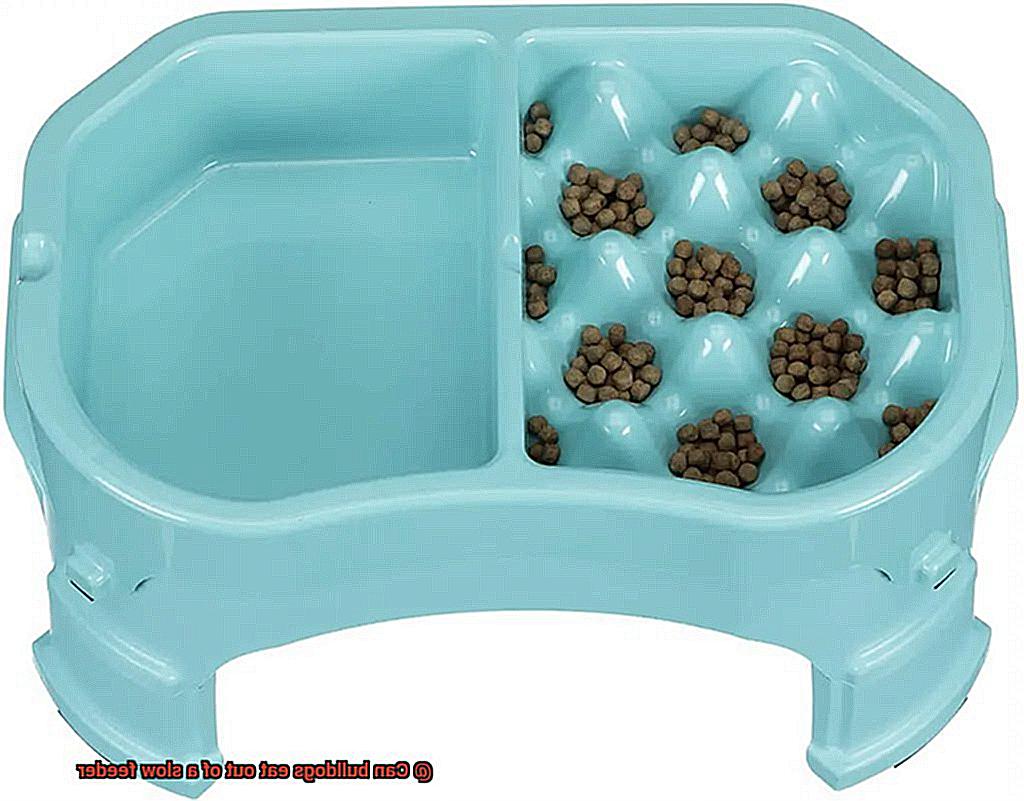
At this stage, your bulldog may need some extra motivation to fully embrace the slow feeder. Try adding some drool-worthy treats or wet food inside to entice them. This makes the experience more enjoyable and gives them an extra incentive to engage with the feeder.
Step 5: Keep an Eye Out
While your bulldog gets the hang of using the slow feeder, keep a close eye on them, especially if they tend to gulp down their food. Bulldogs are notorious for their voracious appetites, and we want to avoid any choking or discomfort. Remember, safety first.
Step 6: Tailoring the Feeder
Every bulldog is unique, just like our own individual tastes. If your bulldog is struggling with a particular slow feeder design, don’t be afraid to switch it up. There are plenty of options out there, so find one that suits your pup’s eating style and preferences. You can even consult with a veterinarian or dog trainer for guidance on choosing the right slow feeder for your four-legged friend.
Remember, Rome wasn’t built in a day, and neither will your bulldog’s transition to the slow feeder. Be patient, stay pawsitive, and provide plenty of encouragement along the way. Soon enough, your furry friend will be chowing down at a slower pace, promoting better digestion and a healthier lifestyle.
Monitoring Your Bulldog’s Eating Habits with a Slow Feeder
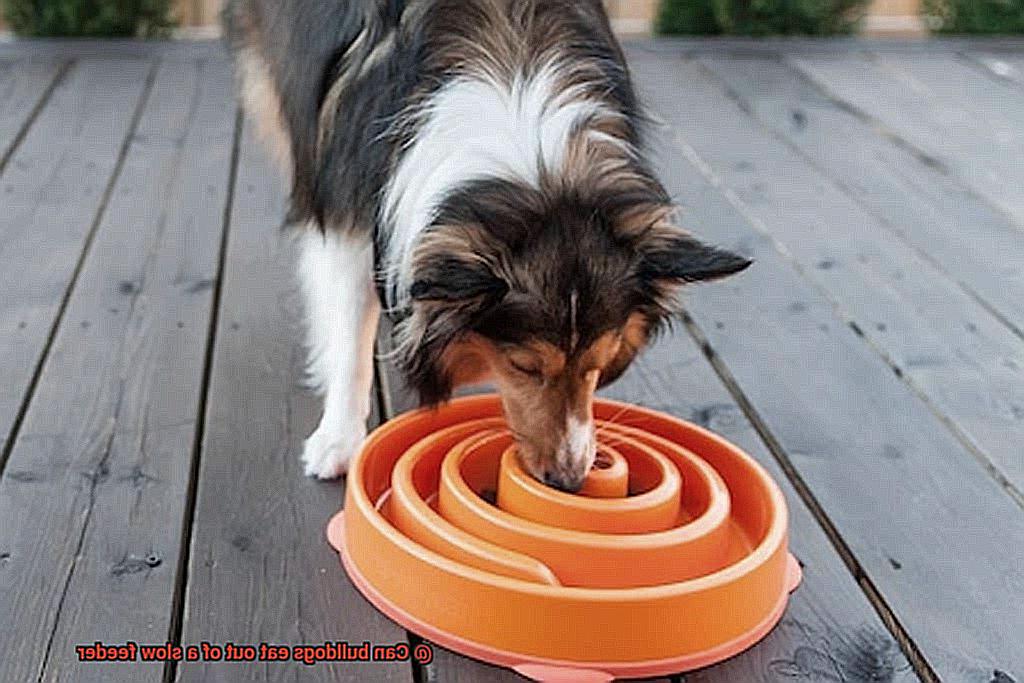
If you’re reading this, chances are you’re well aware of the unique challenges that come with owning a French bulldog. One of those challenges is their tendency to gobble down their food faster than you can say “woof.” But fear not, because today we’re going to dive into the importance of monitoring your bulldog’s eating habits with a slow feeder. So grab a cup of coffee, sit back, and let’s dig in.
Why Bulldogs Need Slow Feeders:
Health Hazards:
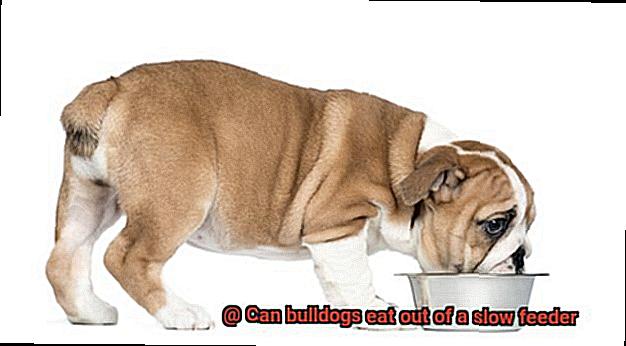
Bulldogs are notorious for their speedy eating habits, but did you know that this can lead to serious health issues? Bloating, choking, and obesity are just a few of the potential problems that can arise from fast eating.
Slowing Down for Better Digestion:
Enter the slow feeder – a specially designed bowl or feeding device that encourages your bulldog to eat at a more leisurely pace. By providing obstacles or barriers, slow feeders make it harder for your furry friend to access their food, promoting smaller bites and thorough chewing.
Preventing Bloating and Gastric Torsion:
When bulldogs gulp down their food in record time, they also tend to swallow excess air. This can lead to bloating and potentially life-threatening gastric torsion. Slow feeders help reduce the risk of these conditions by promoting slower eating and minimizing air intake.
Monitoring Your Bulldog’s Eating Habits:
Gradual Introduction:
Start by introducing the slow feeder gradually. Allow your bulldog to get accustomed to the new feeding device at their own pace.
Observe and Adjust:
Keep an eye on how your bulldog interacts with the slow feeder. Are they able to eat comfortably or do they seem to struggle? If they’re still eating too fast, consider trying a different type of slow feeder that provides more of a challenge.
Watch Their Behavior:
Pay attention to your bulldog’s behavior during meal times. Do they appear frustrated or agitated? This could be a sign that the slow feeder is causing them stress or discomfort.
Weight and Body Condition:
Monitor any changes in your bulldog’s weight or body condition. If they’re not adjusting well to the slow feeder and aren’t getting enough food, it may be necessary to temporarily switch back to a regular bowl.
Monitoring your bulldog’s eating habits with a slow feeder is crucial for their overall well-being. By investing in a slow feeder and closely observing your furry friend’s eating habits, you can help prevent health issues associated with fast eating. Remember, if you have any concerns or need further guidance, don’t hesitate to consult with your veterinarian – they’re always there to lend a helping paw.
What Are the Health Benefits of Using a Slow Feeder for Bulldogs?
If you own a French Bulldog, you’re probably familiar with their hearty appetite and lightning-fast eating habits. However, these habits can lead to various health issues such as obesity, bloating, and gastrointestinal problems. But fear not. Slow feeders are here to save the day and ensure your furry friend’s health by promoting better digestion, preventing bloating and gastric torsion, and allowing you to monitor their eating habits closely. So grab a cup of coffee, sit back, and let’s dive into the world of slow feeders for French Bulldogs.
Slowing Down Eating Speed:
French Bulldogs tend to gulp down their food quickly, which can lead to a range of health problems. Slow feeders are designed with obstacles, ridges, or compartments that make it more challenging for your bulldog to access their food. This encourages them to take smaller bites and chew their food thoroughly, aiding in digestion.
Weight Management:
French Bulldogs are prone to weight gain, which can lead to joint issues, heart disease, and respiratory problems. Slow feeders help control portion sizes and prevent overeating by forcing your bulldog to eat at a slower pace. This can contribute to maintaining a healthy weight and reducing the risk of obesity-related issues.
Bloating Prevention:
French Bulldogs are susceptible to bloating or gastric dilatation-volvulus (GDV) due to their deep chests and large appetites. When they eat too quickly, they may swallow excessive air, leading to bloating and potentially twisting the stomach. Slow feeders minimize the risk of bloating by reducing the amount of air swallowed during meals.
Mental Stimulation:
French Bulldogs are intelligent dogs that require mental challenges to prevent boredom and destructive behavior. Slow feeders make mealtime more mentally stimulating by engaging their problem-solving skills as they navigate through the various obstacles or compartments to access their food. This helps keep their minds active and prevents behavioral issues associated with boredom.
Dental Health:
French Bulldogs are prone to dental problems such as gum disease and tooth decay. Chewing food thoroughly helps clean the teeth by removing plaque and tartar buildup. Slow feeders encourage your bulldog to chew their food more thoroughly, promoting better oral health.
How to Prevent Aggression or Frustration When Using a Slow Feeder for Bulldogs
French Bulldogs are adorable and lovable companions, but their strong food drive can sometimes lead to aggression or frustration, especially when using a slow feeder. However, with the right approach and techniques, you can prevent these negative behaviors and ensure a positive feeding experience for your furry friend.
Gradual Introduction:
To ease your bulldog into using a slow feeder, start by incorporating it for only a portion of their mealtime. Gradually increase the amount of time they spend eating from the slow feeder. This gradual introduction allows them to adjust to the slower pace, reducing their frustration.
Interactive Mealtime:
Make mealtime more engaging for your bulldog by adding puzzle toys or treat dispensers alongside the slow feeder. These toys provide mental stimulation and help distract your bulldog from any frustration they may feel. It’s like turning mealtime into a fun game.
Exercise Before Eating:
A tired bulldog is less likely to exhibit aggression or frustration during mealtime. So, ensure your furry friend gets adequate exercise before their meals. Take them for a walk or engage in active play to burn off excess energy and promote a calmer state of mind.
Positive Reinforcement:
Positive reinforcement is a powerful tool in shaping your bulldog’s behavior. Reward them for calm behavior and patience while using the slow feeder. Verbal praise, treats, or even a special toy or activity after they finish eating can reinforce positive associations with the slow feeder.
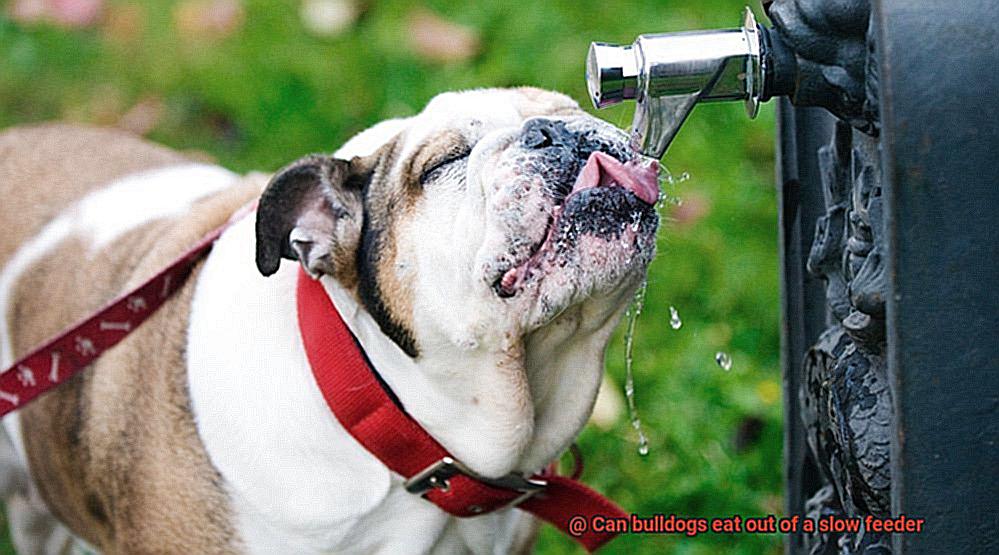
Consult a Professional:
If your bulldog continues to display aggression or frustration despite your efforts, seeking guidance from a professional dog trainer or behaviorist can be beneficial. They can provide personalized strategies and techniques to address your bulldog’s specific needs and help create a stress-free feeding routine.
Tips and Tricks for Getting Your Bulldog Used to Eating Out of a Slow Feeder
Introducing a slow feeder can help solve these concerns. In this article, we will share some tips and tricks to help your bulldog get used to eating out of a slow feeder.
Gradual Introduction:
Start by placing the slow feeder next to their regular bowl during mealtime. Allow your bulldog to sniff and investigate it at their own pace. This helps them become familiar with the new object without feeling pressured to eat from it immediately.
Tempting Treats:
To make the transition easier, mix a small amount of their regular food with some wet food or a tasty treat and place it in the slow feeder. This will entice your bulldog to explore the feeder and associate it with something positive.
Consistency is Key:
Establish a consistent feeding routine by using the slow feeder for every meal. Bulldogs thrive on routines, so this will help them adapt more quickly. Avoid switching back and forth between the slow feeder and regular bowl, as this may confuse your bulldog and prolong the adjustment period.
Familiar Scents:
If your bulldog seems hesitant to eat from the slow feeder, try rubbing a small amount of their favorite treat or some wet food on its surface. This familiar scent can pique their interest and encourage them to eat from it.
Positive Reinforcement:
Use positive reinforcement techniques to encourage your bulldog to eat from the slow feeder. Praise and reward them when they successfully eat from it, reinforcing the behavior for future mealtimes.
Gradual Increase in Difficulty:
As your bulldog becomes more comfortable with the slow feeder, gradually increase the difficulty level. Start with a basic design with larger compartments or obstacles, then transition to one with smaller compartments or more complex patterns. This will challenge their problem-solving skills and keep them engaged during mealtime.
Common Mistakes Made When Using a Slow Feeder with Bulldogs
Bulldogs have unique physical characteristics, such as their short snouts and wide jaws, which can make it difficult for them to eat out of a slow feeder. In this article, we’ll discuss the common mistakes made when using a slow feeder with Bulldogs and provide expert tips to help you navigate these challenges successfully.
Selecting the wrong type or size of feeder:
One of the most common mistakes is choosing a slow feeder that doesn’t suit your bulldog’s needs. Bulldogs have a wider jaw compared to other breeds, so it’s crucial to select a feeder with wider openings or compartments. This ensures that your bulldog can access the food effectively and prevents frustration or abandonment of the feeder.
Not introducing the slow feeder gradually:
Bulldogs can be resistant to change, especially when it comes to their mealtime routine. To help them adjust to the slow feeder, introduce it gradually. Start by placing a small amount of food in the slow feeder alongside their regular bowl, gradually increasing the amount over time. This gradual transition allows your bulldog to get used to the slower eating pace without feeling overwhelmed.
Lack of proper cleaning:
Due to their brachycephalic anatomy, bulldogs are more prone to respiratory issues and allergies. Regularly clean your slow feeder to remove any food particles or bacteria that may accumulate. Neglecting proper cleaning can lead to unpleasant odors, bacterial growth, and potential health issues for your bulldog.
Overfilling the slow feeder:
While it may be tempting to fill the slow feeder to its maximum capacity, avoid overfilling it. Overfilling can make it harder for your bulldog to access the food and may cause spillage or scattering of kibble around the feeder. Follow the manufacturer’s guidelines regarding the appropriate amount of food to be placed in the feeder.
Assuming a slow feeder will solve all eating issues:
While slow feeders can be beneficial in preventing gulping and promoting a healthier eating pace, they may not address underlying behavioral or medical issues related to eating. If your bulldog continues to exhibit abnormal eating behaviors or experiences difficulties with food consumption, consult with a veterinarian or a professional dog behaviorist for further guidance.
Conclusion
Bulldogs, with their adorable wrinkled faces and stocky bodies, may not be the first breed that comes to mind when you think of slow feeders. However, these clever contraptions can actually be a great option for our beloved bulldog friends.
Why is that, you may ask? Well, Bulldogs are notorious for their voracious appetites and tendency to gobble up their food at lightning speed. This can lead to a whole host of issues such as bloating, choking, and even obesity.
Enter the slow feeder – a simple yet effective solution to this problem. These specially designed bowls or mats have ridges, mazes, or obstacles that make it more challenging for your bulldog to get to their food. This forces them to eat slower and take smaller bites, reducing the risk of digestive problems.
But can bulldogs really eat out of a slow feeder? The answer is a resounding yes. While they may initially be puzzled by this new dining experience, bulldogs are intelligent creatures who quickly adapt to change. With a little bit of patience and encouragement from their loving owners, they can learn to navigate the twists and turns of the slow feeder with ease.
Not only does using a slow feeder promote healthier eating habits in bulldogs, but it also provides mental stimulation. Bulldogs are known for being smart but sometimes stubborn dogs. By making mealtime more challenging and engaging, we’re giving them an opportunity to exercise their brains while enjoying their favorite meals.
So next time you’re considering how best to feed your bulldog buddy, don’t overlook the benefits of a slow feeder. It’s an investment in their health and well-being that will pay off in the long run.




